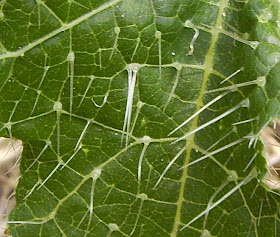In Central Texas , insects aren’t the only thing that will sting you. The plant life is also waiting to make your life completely and utterly miserable if you aren’t careful. Certain plants can and will ruin your day in a serious way. They wait patiently for you stumble into them unaware of their presence and by then it’s too late. You have just experienced a close encounter of the stinging kind. You have also seriously messed up and will now be paying the price for one of nature’s survival lessons.
The stinging nettle (Urtica dioica) is named for the intense stinging sensation that is encountered if you happen to be unlucky enough to make contact with it. This plant has numerous hollow stinging hairs that inject a powerful histamine that causes a skin irritation that results in a redness and a burning sensation that you won’t soon forget. The severe burning and itching sensation caused by a stinging nettle can last for 12 hours or longer depending upon your exposure. The picture above gives you a close up view of the hairs and the bulb-like structures at the base of each hair that contains the chemical that causes all the problems when you come into contact with a stinging nettle.
It’s also an equal opportunity plant. It affects everyone on an equal basis because it causes what is known as irritant dermatitis. This is in contrast to poison oak or poison ivy which causes an allergic dermatitis and may not always result in an allergic reaction from exposure.
The major problem with stinging nettles in Central Texas is that it grows just about all year long and numerous plants can be found growing within a few feet of each other. Stinging nettles are also found in moist areas around creeks or rivers.
Not exactly the best thing if you happen to be aRiverwalker .
Not exactly the best thing if you happen to be a
Got that burning sensation?
Staying above the water line!



Almost as much fun as fire ants, eh?
ReplyDeleteBob
III
If that's what all stinging nettle looks like, I'm thinking I haven't encountered it. I do remember an "outbreak" of some kind of weed when I was a kid. It took a few years for the dads of the neighborhood to get rid of it. Us kids sort of learned what it looked like, and avoided it, but I don't remember it having those big prickles like in your photo.
ReplyDeleteI think I'm not affected by poison ivy. We collected plenty of berries as kids, camped and hiked most summers, and once my ex was covered head to toe with poison ivy rash from our yard, yet I never had a rash. Not sure if I'm not affected by poison oak or not.
To: idahobob
ReplyDeleteFire ants and stinging are definitely not fun...it's best to avoid both if possible.
Thanks Bob III.
RW
To: Shreela
ReplyDeleteStinging nettles spread by rhizomes (underground rootstalks) and can be very hard to eliminate them if you get a patch of them in an area where they aren't wanted.
The pic is a close-up of the needle-like hairs. From a distance they look more like fine hairs and don't look as menacing.
I also don't suffer from the effects of poison oak or poison ivy...unlike many people. The stinging nettle has ruined my day more than once...usually when outside and getting too involved with my activities to pay proper attention to its presence.
Thanks Shreela.
RW
I don't know much about fire ants, next seen or heard of any where I live) but I know stringing nettle more as a benificial weed- kind of like dandelions. Some people still eat it where I live, others make a sort of herbal tea. Funny thing - if you spit out the place where you got within a few minutes the stinging goes away.
ReplyDeleteTo: anonymous 10:30
ReplyDeleteIf you wash the area of the skin where you've come into contact with it, it probably dilutes the chemical on your skin and will reduce its effects.
I know that some people use the roots for medicinal purposes and that they say it can help reduce the joint pain of arthritis.
Thanks anon.
RW
Thanks RW! I looked through a lot of stinging nettle images and found that there's variations, and did find a few that looked more like the "fire grass" we had in our yards. And while looking for pics, I found a website that said to crunch up dock leaves and apply to the nettle rash to relieve the sting of nettles.
ReplyDeleteSince fire ants were also brought up, I normally put vinegar on my ant bites, but with fire ant bites, I have to repeat the vinegar every 3-5 minutes for almost an hour before the fire is put out. Remember to watch out for fire ant "islands" when it floods!
Just to add a little bit, don't try removing it without very thick gloves or a shovel. It roots very deeply and those spikes will penetrate thin gloves. I envy all you lucky buggers who are impervious to Poison Ivy.
ReplyDeleteTo: Shreela
ReplyDeleteI'm pretty sure there is a lot of variations in size, etc. The ones around here can get to be three to four feet tall in more remote areas.
The one in the picture was only a couple of feet high...which about average for my neck of the woods.
Thanks Shreela.
RW
To: Diggity Dog
ReplyDeleteThey can be difficult to get rid of because of their extensive root systems and do well even in the drought conditions we are suffering right now.
It seems as though the weeds are the only thing managing to survive to any extent.
Thanks Diggity.
RW
That is not a stinging nettle plant! Look up stinging nettle in google images.
ReplyDelete